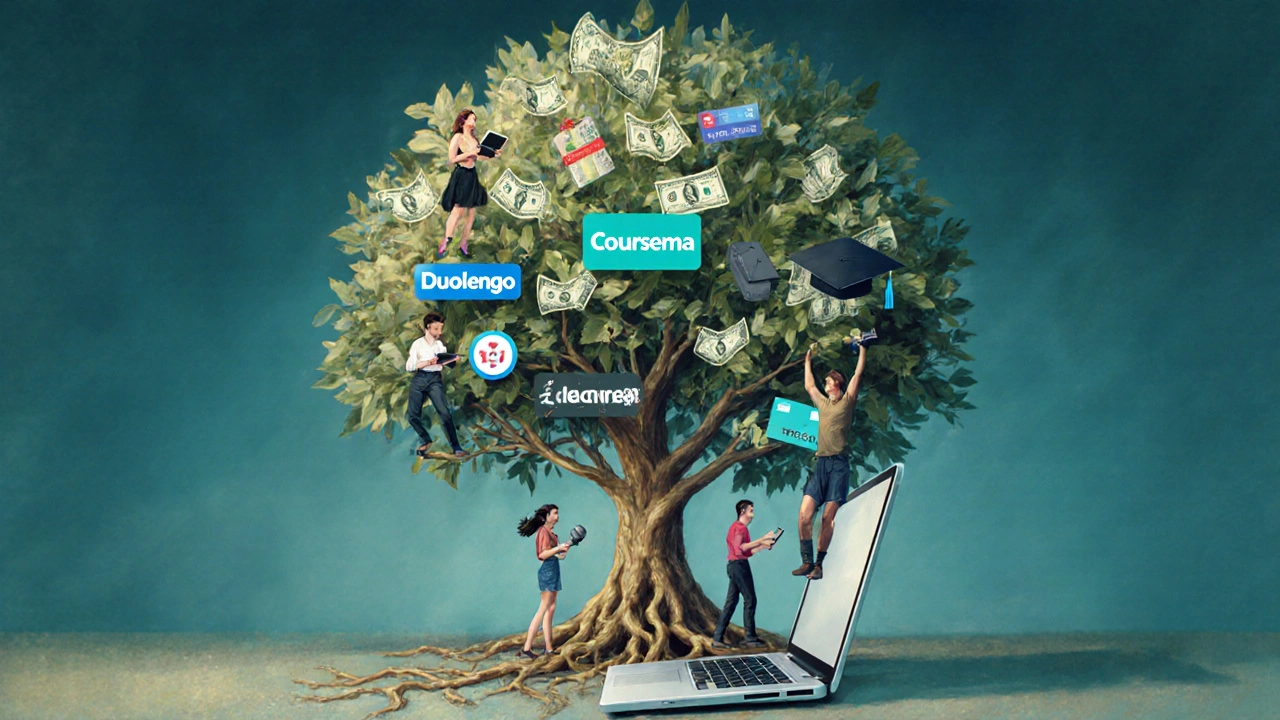Learning Platform Earnings Calculator
How much could you earn?
Select your approach and enter your details to estimate potential earnings from different learning platforms.
Estimated Monthly Earnings
Select your approach and click Calculate to see your potential earnings
Udemy
For course creators who drive their own traffic
Skillshare
For instructors based on view time
Chegg Tutors
For tutors providing one-on-one instruction
Codecademy
For completing projects and courses
Duolingo
For language learning with daily streaks
Most people think online learning is just about spending money-buying courses, subscribing to platforms, studying after work. But what if you could get paid to learn? Not just save money, but actually earn cash, bonuses, or even full-time income while you’re taking classes? It’s not a dream. Some platforms pay learners directly. Others pay you to teach what you’ve learned. And a few even reward you for completing courses with real money.
Platforms that pay you to learn
Not all learning platforms are created equal when it comes to putting money in your pocket. Some are built for passive learning. Others are designed to turn your study time into income. The top platforms that pay learners today don’t just offer certificates-they offer cash, gig opportunities, and performance-based rewards.
Udemy doesn’t pay you to take courses. But if you create a course and it sells, you keep up to 97% of the revenue. That’s how thousands of people turned their expertise into full-time income. A data analyst in India made $12,000 in six months by teaching Excel automation. A retired teacher in Canada earns $3,000/month teaching Spanish to Brazilian students. These aren’t outliers. They’re regular people who used Udemy as a platform to monetize their knowledge.
Coursera takes a different approach. Through its Coursera for Campus and Coursera for Government programs, learners in partner institutions get free access to courses-and in some cases, cash bonuses for completing special tracks. In 2024, a pilot program in Nigeria paid students $50 for finishing a data literacy course and passing a final project. Over 12,000 students earned payouts through this initiative.
Skillshare operates on a subscription model, but it has a unique creator payout system. If you’re a teacher on Skillshare, you earn based on how many minutes of your classes students watch. A single instructor in Mexico earned $8,400 in one year just from teaching basic graphic design. The platform pays out monthly, and you don’t need to be an expert-just clear and consistent.
Platforms that pay you to teach what you learn
One of the most powerful ways to get paid while learning is to become a tutor or teaching assistant. Platforms like Tutor.com, Chegg Tutors, and Varsity Tutors hire learners who are already studying a subject to help others. You don’t need a degree. You need to be one step ahead.
For example, a college student in Texas studying biology started tutoring high schoolers on Chegg for $20/hour. Within three months, she was earning $1,200/month while studying for her own exams. She used her tutoring income to pay for her Coursera bioinformatics course. That course then helped her land a paid research internship.
Teachable and Thinkific let you build your own course store. You can start with free content from YouTube or Khan Academy, then package it into a structured course. A student in Kenya used free MIT OpenCourseWare materials to create a Python for Beginners course on Teachable. He sold 320 copies in six months at $15 each-earning $4,800. He reinvested the money into a premium course on machine learning.
Learning platforms with direct cash rewards
Some platforms are built to pay you just for completing lessons. These aren’t just certificates-they’re payouts.
Brilliant.org has a “Learn and Earn” program. If you complete a 30-day streak in math or computer science, you get entered into a monthly draw for cash prizes. In 2025, 12 winners received $500 each. The odds are low, but the barrier to entry is zero.
Codecademy’s Pro plan includes a “Build & Get Hired” track. After finishing a project (like building a portfolio website or a simple app), you can submit it for review. If approved, Codecademy connects you with hiring partners-and pays you $100 as a completion bonus. Over 18,000 learners have claimed this bonus since 2023.
And then there’s Duolingo. Yes, Duolingo. The language app started paying users in 2024 through its “Duolingo Rewards” program. Users who complete daily streaks and pass proficiency tests can earn points redeemable for gift cards. One user in the Philippines earned $78 in gift cards over four months just by studying Spanish for 15 minutes a day.

What’s the highest-paying platform?
If you’re asking which platform pays the most, the answer depends on what you’re willing to do.
For passive income: Udemy. If you create a course that sells consistently, you can earn thousands per month with almost no ongoing work. One instructor in Brazil makes $22,000/year teaching Excel for accountants-without ever updating the course.
For active income: Chegg Tutors or Varsity Tutors. If you’re good at explaining things and have time to spare, tutoring can pay $25-$50/hour. That’s more than most part-time jobs.
For low-effort cash: Codecademy and Duolingo. You get $100 or $5 gift cards just for sticking with it. It’s not life-changing, but it’s free money.
For scalability: Teachable or Thinkific. You build your own brand. No platform takes a cut of your future sales. You keep 100%-but you also handle marketing, tech, and customer service.
Who actually makes money from learning platforms?
It’s not just the top 1% of instructors. Real people with real jobs are earning extra cash.
- A warehouse worker in Ohio took a free Coursera course on supply chain management. He used what he learned to improve his team’s workflow. His manager noticed. He got promoted-and the company paid for his next course.
- A single mom in Mexico City used Skillshare to learn Canva. She started designing social media posts for local bakeries. Now she earns $1,500/month as a freelance designer.
- A college student in Indonesia learned web development on freeCodeCamp. He built a simple booking site for a local surf school. They paid him $800 upfront. He used that money to buy a domain and launch his own site.
These aren’t success stories from Silicon Valley. They’re everyday people using learning platforms as tools-not just to grow, but to earn.

How to start earning from a learning platform today
You don’t need to be an expert. You just need to start.
- Choose a skill you’re already learning or want to learn.
- Find a platform that pays for that skill-whether it’s tutoring, course creation, or completion bonuses.
- Complete one course or project.
- Apply for any payout or reward program.
- Use what you earned to fund your next course.
Don’t wait for the perfect time. Don’t wait until you know everything. Start with what you know now. Teach it. Build on it. Get paid for it.
Common mistakes that stop people from earning
Many people sign up for platforms but never get paid. Here’s why:
- They only take courses-they never create or teach.
- They expect instant payouts. Most platforms require 3-6 months of consistent effort.
- They pick a platform that doesn’t pay learners (like Khan Academy or edX). They assume all platforms pay.
- They don’t track their progress. If you’re not logging hours, projects, or earnings, you won’t see results.
The biggest mistake? Thinking you need to be perfect before you start earning. You don’t. You just need to be one step ahead of someone else.
Final thoughts: Learning isn’t a cost-it’s an investment
For decades, we’ve been told education is an expense. You pay tuition. You pay for books. You pay for subscriptions. But that’s outdated. Today, learning can be an asset. You can turn your study time into income. You can build skills that pay you back-sometimes faster than any job.
The platform that pays the most isn’t the one with the fanciest interface. It’s the one you use consistently. The one where you take action-not just watch videos. The one where you teach, build, or complete something real.
Start today. Pick one platform. Do one thing. Get paid for it.
Can you really get paid to take online courses?
Yes-but not always for just watching videos. Platforms like Codecademy, Coursera (in select programs), and Duolingo offer cash rewards, gift cards, or bonuses for completing projects, passing tests, or maintaining streaks. You won’t get paid for passive learning, but you can earn by doing something with what you learn-like building a project, tutoring, or teaching.
Which platform pays the most for course creators?
Udemy pays the highest percentage to instructors-up to 97% of revenue per sale. But you need to drive your own traffic. Teachable and Thinkific let you keep 100% of sales, but you handle marketing, payments, and tech. If you’re good at promotion, Teachable wins. If you want built-in students, Udemy does.
Do I need experience to teach on learning platforms?
No. You don’t need a degree or professional title. Platforms like Skillshare, Udemy, and Chegg Tutors accept learners who are one step ahead. If you’ve completed a course and can explain it clearly, you can teach it. Many top instructors started as students themselves.
How long does it take to start earning from a learning platform?
It varies. For tutoring, you can start earning in days after signing up. For course creation, it takes 2-6 months to build an audience and make sales. Completion bonuses (like Codecademy’s $100) can come in as little as two weeks if you finish the required project. Patience and consistency matter more than speed.
Are there free learning platforms that pay?
Yes. FreeCodeCamp doesn’t pay directly, but it connects learners to paid internships and jobs. Duolingo gives gift cards for streaks. Coursera offers cash bonuses in select countries through government or university partnerships. You don’t need to pay to earn-you just need to take action.


